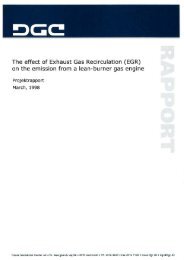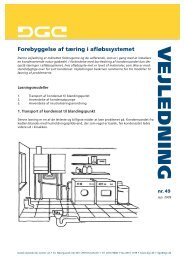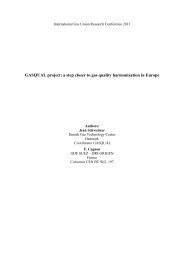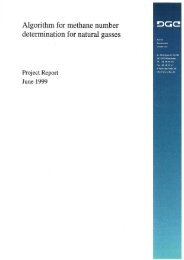The Composite Radiosity and Gap (CRG) Model of Thermal Radiation
The Composite Radiosity and Gap (CRG) Model of Thermal Radiation
The Composite Radiosity and Gap (CRG) Model of Thermal Radiation
You also want an ePaper? Increase the reach of your titles
YUMPU automatically turns print PDFs into web optimized ePapers that Google loves.
Introduction<br />
In most cases radiation models are used for finding the radiant source <strong>and</strong> sink terms for CFD<br />
modelling. <strong>The</strong>se terms are then put into the transport equation for enthalpy giving the temperature<br />
distribution in the topical case. Other results from the radiation models are the heat<br />
fluxes <strong>and</strong> heat transfer to the walls <strong>of</strong> the case in question. From this information the heat<br />
load on the boiler tubes or the furnaces walls can be calculated.<br />
Many models for thermal radiation include constants for the absorption coefficient a <strong>and</strong><br />
for the mean beam length L m . This is adequate for some special cases as cubic or spherical<br />
geometries with almost constant temperatures <strong>and</strong> concentrations. However, in most cases it<br />
is necessary to be able to use varying values <strong>of</strong> the mean beam length <strong>and</strong> the absorption. In<br />
the <strong>CRG</strong>-model there are no restrictions for the variation <strong>of</strong> these variables. However, the<br />
absorption <strong>and</strong> the scattering must be isotropic.<br />
<strong>The</strong> sink term <strong>of</strong> any point in the furnace is rather easily calculated, given from the fact that<br />
this term is only dependent on the conditions <strong>of</strong> the point in question. <strong>The</strong> source term at any<br />
point related to thermal radiation is however dependent on the condition <strong>of</strong> the whole furnace<br />
or geometry in question. <strong>The</strong> present model focuses on calculation <strong>of</strong> the source term for the<br />
thermal radiation.<br />
<strong>The</strong> <strong>Radiosity</strong> model<br />
<strong>The</strong> flux equation <strong>of</strong> thermal radiation, which is valid regardless <strong>of</strong> the optical thickness /1/, is<br />
given by:<br />
dqi<br />
= 4 a( eb<br />
− R)<br />
[W/m 3 ] (1)<br />
dx<br />
i<br />
where q i is the radiant flux. <strong>The</strong> term e b is given by :<br />
4<br />
e b<br />
= σT<br />
[W/m 2 ] (2)<br />
Above a is the absorption coefficient, σ is the Stefan Boltzmanns constant <strong>and</strong> T is<br />
the temperature in Kelvin <strong>of</strong> the fluid. <strong>The</strong> term R is the radiosity (W/m 2 ) which is the<br />
incoming radiation at any point. <strong>The</strong> total source term for the energy equation /1/ is found by:<br />
S<br />
rad<br />
dq<br />
( R − e )<br />
i<br />
= − = 4 a<br />
b<br />
[W/m 3 ] (3)<br />
dxi<br />
As pointed out above the sink term is relatively easily calculated. It is given by the equation:<br />
S<br />
rad, sink<br />
4<br />
= −4aσT<br />
[W/m 3 ] (4)<br />
<strong>The</strong> source term <strong>of</strong> radiation is much more difficult to calculate. <strong>The</strong> source term is found as<br />
the radiation coming in from all directions towards the topical point. This term is dependent<br />
on the conditions in all parts <strong>of</strong> the geometry, as thermal radiation does not follow the st<strong>and</strong>ard<br />
transport equation for a fluid scalar, <strong>and</strong> it comes from walls as well as from the gas itself.






![Hybrid heating systems and smart grid [PDF] - Danish Gas ...](https://img.yumpu.com/46620218/1/184x260/hybrid-heating-systems-and-smart-grid-pdf-danish-gas-.jpg?quality=85)









